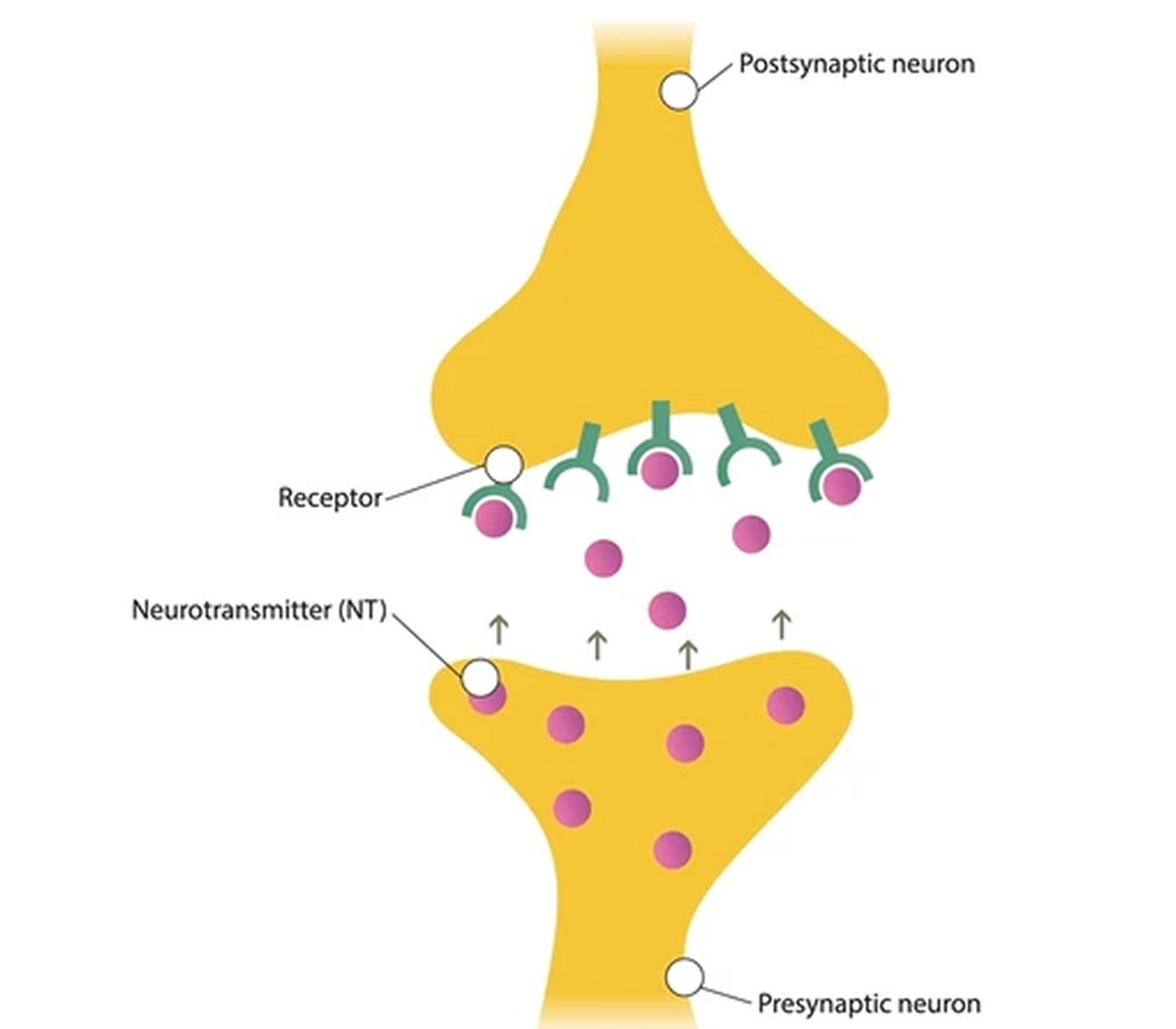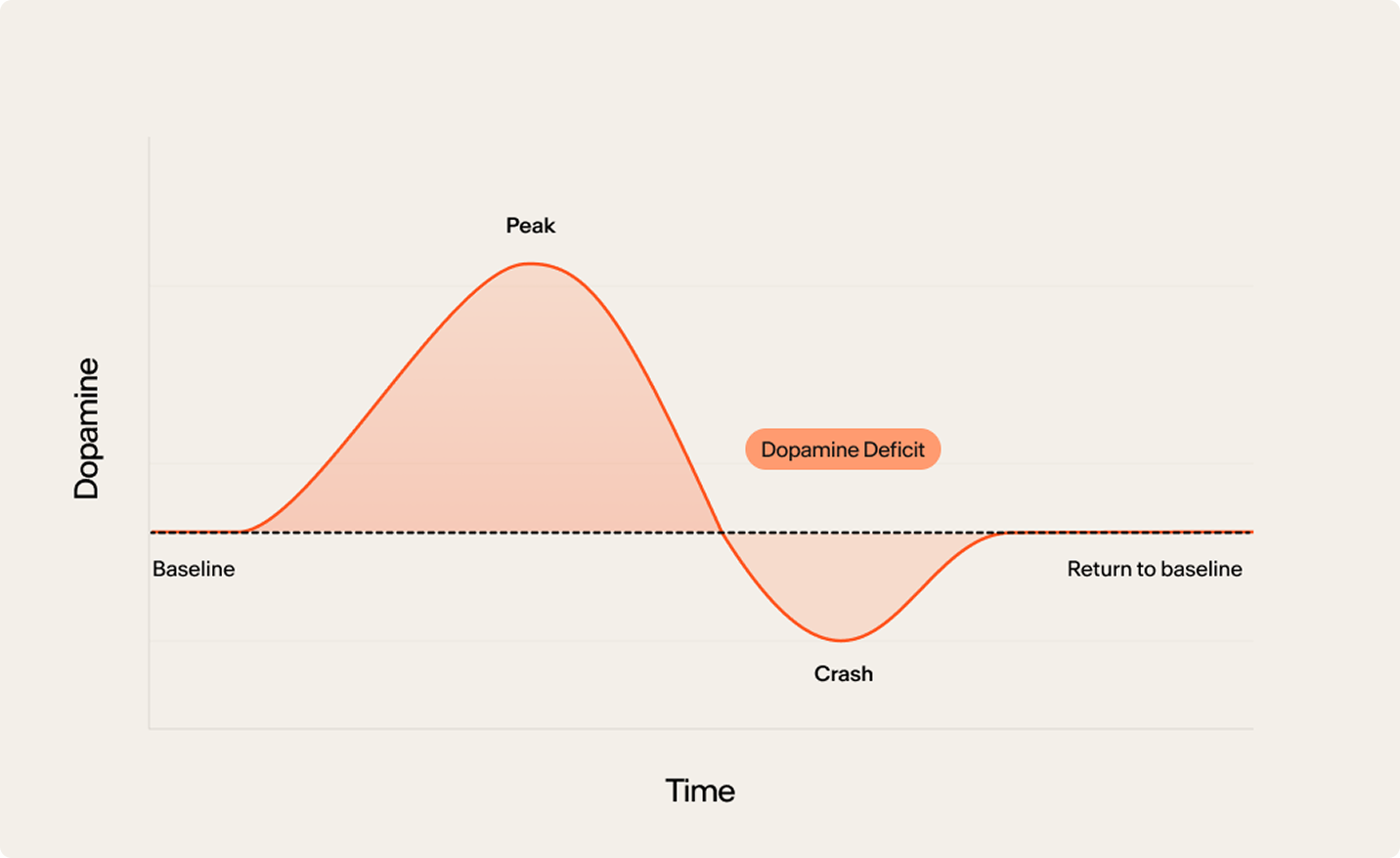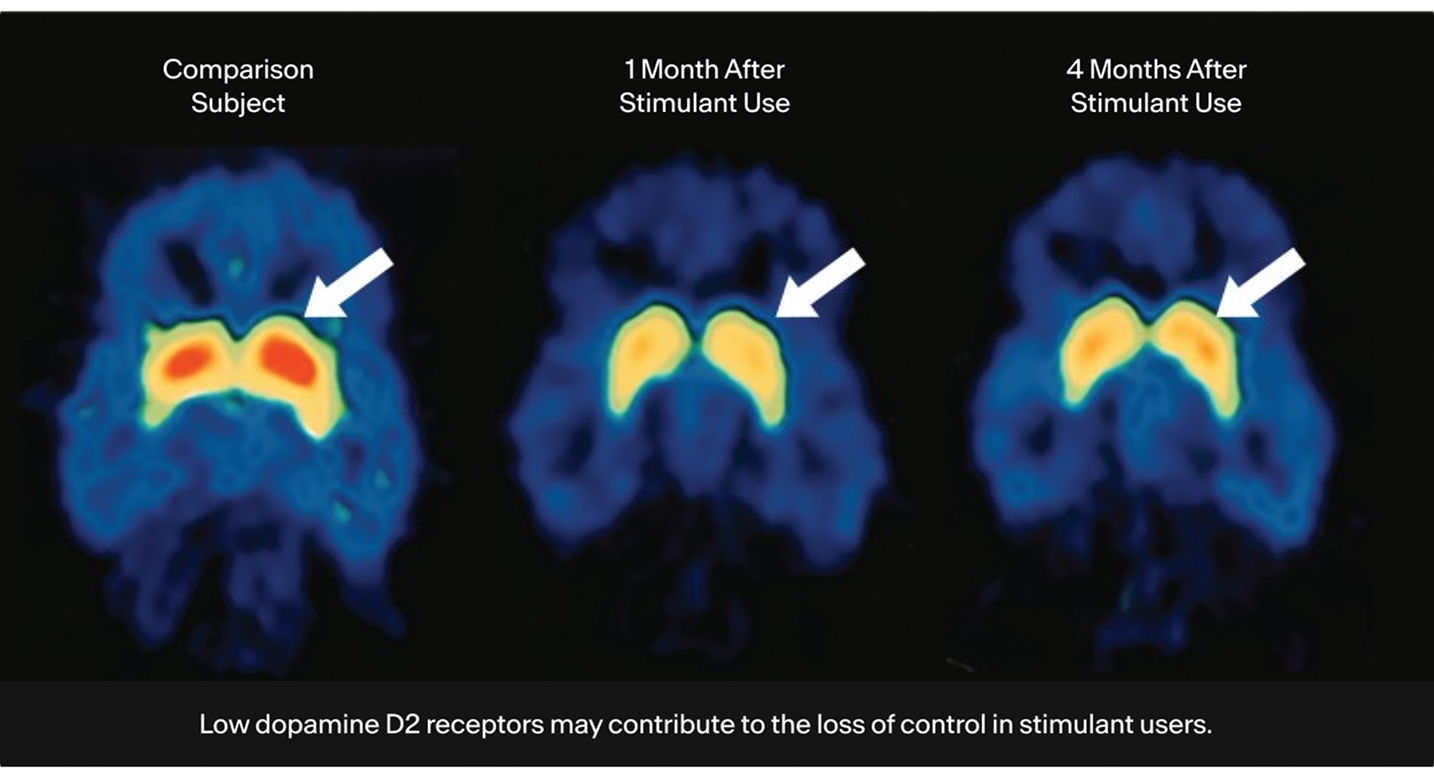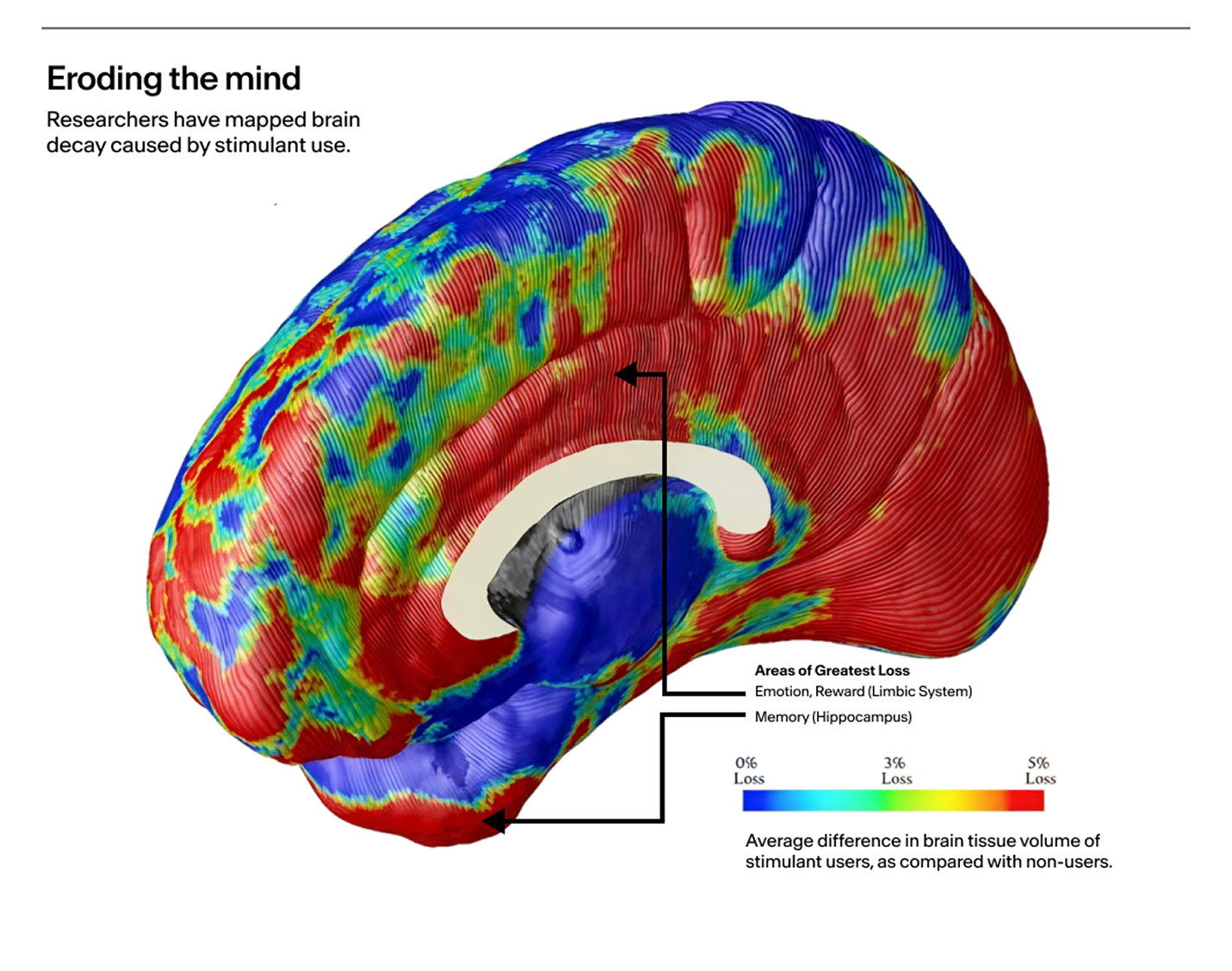Stimulants & Dopamine Rebound
Exploring how dopamine crashes affect mood regulation and cognitive performance, and how targeted interventions can restore balance and support neurological function
June 2, 2025

What Is Dopamine Rebound and Why Does It Matter?
This information is for educational purposes only and is not intended as medical advice. Please consult a healthcare professional for any health concerns.
Dopamine is a neurotransmitter for motivation, reward, pleasure, attention, and movement.7 It fires up when you're excited by a new idea or when your favorite song hits just right. Stimulants are widely known for enhancing alertness and cognitive performance by increasing levels of stimulatory neurotransmitters. For example, methylphenidate cranks up dopamine by blocking its reuptake.47,38
Amphetamines, including dexamphetamine, take it a step further by releasing even more dopamine into the synapse.8 Then there’s Lisdexamfetamine, designed to deliver a steadier dopamine increase, avoiding the sharp spikes (and crashes) that follow.50,4,48 Even caffeine gets in on the action by indirectly raising dopamine levels through blocking adenosine receptors.19
But what goes up must come down. When stimulant effects fade, many users face what's known as dopamine rebound or “crash”— dopamine levels drop below your usual baseline. The results? Fatigue, irritability, and that familiar cognitive fog, similar to the emotional letdown after an adrenaline rush or the post-concert blues.44,18 What’s occurring is a biological cascade: When stimulants overstimulate the dopamine system, synaptic dopamine is depleted, presynaptic D2 autoreceptors become hyperactive, and dopamine transporters/internalized receptors reduce reuptake and signaling efficiency. This leads to hyperpolarization and reduced firing of dopamine neurons, causing dopamine levels to drop below baseline and resulting in a temporary “crash” until the brain can restore its balance through receptor recycling and dopamine resynthesis.8 The system thus swings from overstimulation to underperformance and needs time to reset before returning to normal function.44,36,37,30
During this dip, you might not just feel sluggish – you might crave another boost. Over time, this can nudge the brain toward tolerance and dependence as it starts to rely more and more on these dopamine boosts.44,49,22

That’s why learning how to manage the dopamine rebound is so important. Supporting the brain during this low period not only helps prevent the cycle of dependence but also gives the brain’s reward system the breathing room it needs to recover and recalibrate. Strategies like engaging in naturally rewarding activities or using targeted supplements can help support healthy dopamine levels and mood for a smooth transition back to baseline.28,13
What You Experience
When the effects of stimulants wear off, the brain often overcorrects, leading to a short-term dopamine deficit. This dip in dopamine may seem like a temporary crash, but its effects on the brain and body can be more widespread than they initially appear.
Behavioral and Physiological Effects
Some common behavioral and physiological side effects include:
Fatigue
Dopamine depletion leads to low energy, hypersomnolence, and reduced motivation, similar to post-exertion exhaustion.14
Sadness/Anhedonia
The brain's reward system is blunted, resulting in low mood and loss of pleasure in previously enjoyable activities.15
Apathy
Motivation and interest in activities decline, with everyday tasks feeling unimportant or uninteresting.29
Irritability
Emotional regulation is impaired, making individuals more prone to mood swings and frustration.38
Social Withdrawal
Social interactions become less rewarding, leading to isolation and reduced desire for connection.45
Cognitive Impairment
Attention, working memory, and executive function suffer, manifesting as distractibility and "brain fog".14,31

What’s Happening Inside Your Brain
Ventral Striatum (Reward Circuitry)
The ventral striatum becomes hyperdependent on exogenous dopamine. In adults, acute dexamphetamine use increases striatal dopamine by 150%, but withdrawal reduces levels below baseline within hours, causing fatigue and cravings. This deficit disrupts motivation and decision-making.46,34
Prefrontal Cortex (Executive Function)
The PFC, reliant on tonic dopamine for working memory and impulse control, suffers during rebound. fMRI studies reveal reduced connectivity between the PFC and striatum in adults post-stimulant use, correlating with "brain fog" and emotional lability. DAT upregulation in this region further starves synapses of dopamine, worsening attention deficits.17,41,52
Substantia Nigra and Nigrostriatal Pathway
The substantia nigra, which supplies dopamine to the dorsal striatum (motor control), is indirectly affected. Chronic stimulant use reduces nigrostriatal dopamine storage, contributing to motor fatigue and restlessness during crashes.43,2
How Your Body Responds
Hypothalamic-Pituitary-Adrenal (HPA) Axis Dysregulation
Dopamine depletion disrupts stress hormone (cortisol) regulation, causing prolonged elevation, cardiovascular strain, and rebound hunger/metabolic shifts.21,36
Sleep-Wake Cycle Disruption
Reduced dopamine signaling impairs arousal and sleep-wake cycles, leading to decreased sleep efficiency and daytime drowsiness.36,44
Oxidative Stress
Chronic stimulant use increases oxidative stress in dopamine terminals, potentially contributing to long-term cognitive issues.21,39
Best Practices for Modulating Cortisol

1. Stress Management
Consistent stress increases the risk of stimulant misuse and worsens withdrawal symptoms. Exercise and mindfulness can help stabilize dopamine and reduce crash intensity.9,5
2. Hydration
Regular water and electrolyte intake helps maintain brain function and overall homeostasis. It also supports the kidneys in flushing out toxins, including residual stimulants, helping to reduce the duration and severity of the crash.1,51,40
3. Protect Dopamine Neurons
Chronic stimulant use increases oxidative stress, which may damage dopamine-producing neurons and worsen mood crashes. Antioxidant-rich foods may help protect these neurons.44,10

4. Dopamine Precursors
Supplementing with L-tyrosine or phenylalanine may help support healthy dopamine levels when used alongside stimulants, but should only be done under medical supervision to avoid overstimulation.6,24
5. Supplementation of Cofactors
Adequate intake of iron, zinc, magnesium, and B6 supports dopamine synthesis and has been shown to help reduce crash symptoms.3,42
Stasis Contains Co-factors to Maintain Healthy Dopamine Synthesis
Please note that Stasis is a dietary supplement that helps support healthy dopamine levels. It is not intended to diagnose, treat, cure, or prevent any disease.
Magnesium
Magnesium plays a critical role by helping the brain’s main dopamine-making enzyme (called tyrosine hydroxylase) work properly. It also protects brain cells from overstimulation, supports healthy brain connections, and boosts important growth factors like BDNF, which keep your brain resilient and flexible27. On top of that, magnesium supports the energy factories inside your cells (your mitochondria), making sure your brain has the fuel it needs to produce dopamine efficiently.27,20
Zinc
Zinc helps your brain use dopamine efficiently by supporting the transporters that move dopamine in and out of brain cells32,35. It also helps release dopamine when needed and keeps brain cell activity balanced. Plus, zinc is important for the process of turning dopamine into another neurotransmitter involved in focus and alertness called norepinephrine.32,23
Folate (Vitamin B9)
Folate (Vitamin B9) is essential for making and balancing brain chemicals like dopamine. It helps your brain’s main dopamine-making enzyme work properly and protects brain cells from stress. Folate also supports healthy levels of homocysteine, which is important for keeping your brain sharp and your mood steady.26
Pyridoxine (Vitamin B6)
Vitamin B6 (Pyridoxine) supports the enzymes your brain uses to make dopamine and helps manage natural byproducts of dopamine metabolism, keeping brain signaling healthy. Adult studies show vitamin B6 may help with maintaining balanced neurotransmitter activity and processing metabolic byproducts.16
Vitamin B12
Vitamin B12 works with folate to support dopamine production and helps keep nerve cells healthy.33 It also protects the “insulation” around nerves, which helps signals travel smoothly in dopamine pathways.12
Curcumin
Curcumin, a key compound found in turmeric, has been shown in animal studies to help maintain levels of dopamine in the brain by inhibiting monoamine oxidase (MAO), the enzyme responsible for it down24. Likewise, in humans, clinical trials have found curcumin improves mood, reduces fatigue, and enhances working memory, consistent with improved neurotransmitter function and hippocampal activity.11
Key Study Summaries
The following information is for educational purposes only and is not intended as medical advice. These statements have not been evaluated by the Food and Drug Administration. This information is not intended to diagnose, treat, cure, or prevent any disease, nor is it intended to promote any specific product.
Dopamine and Mechanism of Action of Amphetamines
Berman et al. (2009) described how amphetamines increase synaptic dopamine by blocking reuptake via the dopamine transporter (DAT), inducing reverse dopamine transport, and disrupting vesicular storage through VMAT2 inhibition. These actions raise cytoplasmic dopamine, which is then expelled into the synapse independent of neuronal firing. Amphetamines also inhibit monoamine oxidase enzymes (MOA), further boosting dopamine levels. At therapeutic doses, this enhances safe levels of dopamine activity in the brain, which helps sharpen attention and improve focus. At higher doses, however, it causes excessive and uncontrolled dopamine release, oxidative stress and impacts overall brain health.4
Zinc, The Dynamic Dopamine Regulator
A 2008 study revealed that zinc’s influence on dopamine transport in the brain is far more dynamic and context-dependent than previously understood. Zinc binds directly to the dopamine transporter (DAT), the protein responsible for clearing dopamine from the synapse. Intriguingly, zinc’s effect on dopamine reuptake can reverse depending on the cell’s membrane potential and chloride levels: in some conditions, zinc slows dopamine reuptake, while in others, it speeds it up. This discovery highlights a hidden layer of regulation in brain chemistry, showing that zinc’s impact on dopamine is shaped by the electrical and chemical environment of the cell.35
Why Only Some Stimulants Cause a Crash
A 2009 study by Gruner et al. explored why rebound hypersomnolence-the notorious “crash” of excessive sleepiness after stimulant use-occurs with amphetamines but not with caffeine. Using animal models, the researchers found that dopamine-releasing drugs like amphetamine and methamphetamine triggered a sudden, intense need for sleep after their effects wore off, while caffeine (which works through adenosine rather than dopamine) did not cause this crash at all. Even when both drugs produced the same amount of wakefulness, only the dopamine-based stimulants led to a rebound. The study also discovered that combining amphetamine with certain dopamine transporter inhibitors could prevent this crash, suggesting new ways to manage stimulant side effects.19
-
Citations:
- Ambati, R. R., Phang, S. M., Ravi, S., & Aswathanarayana, R. G. (2014). Astaxanthin: Sources, extraction, stability, biological activities, and its commercial applications—a review. Marine Drugs, 12(1), 128–152. https://doi.org/10.3390/md12010128
- Aseervatham, G. S. B., Sivasudha, T., Jeyadevi, R., Ananth, D. A., Kumaresan, K., & Ravikumar, S. (2013). Environmental factors and unhealthy lifestyle influence oxidative stress in humans—an overview. Environmental Science and Pollution Research, 20(7), 4356-4369. https://doi.org/10.1007/s11356-013-1748-0
- Atrooz, F., & Salim, S. (2020). Sleep deprivation, oxidative stress, and inflammation. Advances in Protein Chemistry and Structural Biology, 119, 309-336. https://doi.org/10.1016/bs.apcsb.2019.03.001
- Azzi, A. (2022). Oxidative stress: What is it? Can it be measured? Where is it located? Can it be good or bad? Can it be prevented? Can it be cured? Antioxidants, 11(8), 1431. https://doi.org/10.3390/antiox11081431
- Balic, I., Obradović, D., & Tomašević, M. (2018). Superoxide dismutase-derived products: Extramel® and their impact on oxidative stress biomarkers. Antioxidants, 7(4), 55. https://doi.org/10.3390/antiox7040055
- Belviranlı, M., & Okudan, N. (2021). Melon-derived superoxide dismutase (Extramel®) improves cognitive performance and reduces oxidative stress in older adults. Clinical Interventions in Aging, 16, 1355–1363. https://doi.org/10.2147/CIA.S326598
- Carillon, J., Rouanet, J. M., Cristol, J. P., & Brion, R. (2013). Superoxide dismutase administration, a potential therapy against oxidative stress-related diseases: Several routes of supplementation and proposal of an original mechanism of action. Pharmaceutical Research, 30(11), 2718–2728. https://doi.org/10.1007/s11095-013-1113-5
- Carvalho, F., Fernandes, E., Remião, F., Gomes-Da-Silva, J., Tavares, M. A., & Bastos, M. D. (2001). Adaptive response of antioxidant enzymes in different areas of rat brain after repeated d-amphetamine administration. Addiction Biology, 6(3), 213–221. https://doi.org/10.1080/13556210120056544
- Cristol, J. P., Carillon, J., & Brion, R. (2014). Extramel® supplementation reduces stress, fatigue, and oxidative stress in humans: A randomized, placebo-controlled study. Nutrients, 6(6), 2348–2359. https://doi.org/10.3390/nu6062348
- Fassett, R. G., & Coombes, J. S. (2011). Astaxanthin: A potential therapeutic agent in cardiovascular disease. Marine Drugs, 9(3), 447–465. https://doi.org/10.3390/md9030447
- Franzoni, F., Scarfò, G., Guidotti, S., Fusi, J., Asomov, M., & Pruneti, C. (2021). Oxidative stress and cognitive decline: The neuroprotective role of natural antioxidants. Frontiers in Neuroscience, 15. https://doi.org/10.3389/fnins.2021.729757
- Friedman, J. (2010). Why is the nervous system vulnerable to oxidative stress? Oxidative Stress and Free Radical Damage in Neurology, 19–27. https://doi.org/10.1007/978-1-60327-514-9_2
- Govitrapong, P., Boontem, P., Kooncumchoo, P., Pinweha, S., Srisurapanont, M., & Kotchabhakdi, N. (2010). Increased blood oxidative stress in amphetamine users. Addiction Biology, 15(1), 100-102. https://doi.org/10.1111/j.1369-1600.2009.00176.x
- Greenhill, L. L., Pliszka, S., & Dulcan, M. K. (2002). Practice parameter for the use of stimulant medications in the treatment of children, adolescents, and adults. Journal of the American Academy of Child & Adolescent Psychiatry, 41(2 Supplement), 26S-49S. https://doi.org/10.1097/00004583-200202001-00003
- Guerin, M., Huntley, M. E., & Olaizola, M. (2003). Haematococcus astaxanthin: Applications for human health and nutrition. Trends in Biotechnology, 21(5), 210–216. https://doi.org/10.1016/S0167-7799(03)00078-7
- Hariharan, S., & Dharmaraj, S. (2020). Selenium and selenoproteins: Its role in regulation of inflammation. Inflammopharmacology, 28, 667–695. https://doi.org/10.1007/s10787-020-00690-x
- Higuera-Ciapara, I., Félix-Valenzuela, L., & Goycoolea, F. M. (2006). Astaxanthin: A review of its chemistry and applications. Critical Reviews in Food Science and Nutrition, 46(2), 185–196. https://doi.org/10.1080/10408690590957188
- Huang, M., Lin, S., Chen, C., Pan, C., Lee, C., & Liu, H. (2013). Oxidative stress status in recently abstinent methamphetamine abusers. Psychiatry and Clinical Neurosciences, 67(2), 92–100. https://doi.org/10.1111/pcn.12025
- Juárez Olguín, H., Calderón Guzmán, D., Hernández García, E., & Barragán Mejía, G. (2016). The role of dopamine and its dysfunction as a consequence of oxidative stress. Oxidative Medicine and Cellular Longevity, 2016, Article 9730467. https://doi.org/10.1155/2016/9730467
- Kooncumchoo, P., Sharma, S., Porter, J., Govitrapong, P., & Ebadi, M. (2006). Coenzyme Q10 provides neuroprotection in iron-induced apoptosis in dopaminergic neurons. Journal of Molecular Neuroscience, 28(2), 125-141. https://doi.org/10.1385/JMN:28:2:125
- Liu, F., Huang, J., Hei, G., et al. (2020). Effects of sulforaphane on cognitive function in patients with frontal brain damage: Study protocol for a randomized controlled trial. BMJ Open, 10, e037543. https://doi.org/10.1136/bmjopen-2020-037543
- Lu, J., & Holmgren, A. (2009). Selenoproteins. Journal of Biological Chemistry, 284(2), 723–727. https://doi.org/10.1074/jbc.R800045200
- Mead, A., Delibaş, B., Önger, M. E., & Kaplan, S. (2024). The potential positive effects of coenzyme Q10 on the regeneration of peripheral nerve injury. Exploration of Neuroprotective Therapy, 4, 288–299. https://doi.org/10.37349/ent.2024.00083
- Mirecki, Anna et al. “Brain antioxidant systems in human methamphetamine users.” Journal of neurochemistry vol. 89,6 (2004): 1396-408. doi:10.1111/j.1471-4159.2004.02434.x
- Nouchi, R., Hu, Q., Ushida, Y., Suganuma, H., & Kawashima, R. (2022). Effects of sulforaphane intake on processing speed and negative moods in healthy older adults: Evidence from a randomized controlled trial. Frontiers in Aging Neuroscience, 14. https://doi.org/10.3389/fnagi.2022.929628
- Office of Dietary Supplements. (2024). Selenium: Fact sheet for health professionals. National Institutes of Health. Accessed January 6, 2025. https://ods.od.nih.gov/factsheets/Selenium-HealthProfessional/
- Pashkow, F. J., Watumull, D. G., & Campbell, C. L. (2008). Astaxanthin: A novel potential treatment for oxidative stress and inflammation in cardiovascular disease. American Journal of Cardiology, 101(10A), 58D–68D. https://doi.org/10.1016/j.amjcard.2008.02.010
- Shah, A., Varma, M., & Bhandari, R. (2024). Exploring sulforaphane as neurotherapeutic: Targeting Nrf2-Keap & NF-kB pathway crosstalk in ASD. Metabolic Brain Disease, 39(2), 373–385. https://doi.org/10.1007/s11011-023-01224-4
- Sharp, M., Sahin, K., Stefan, M., Orhan, C., Gheith, R., Reber, D., Sahin, N., Tuzcu, M., Lowery, R., Durkee, S., & Wilson, J. (2020). Phytoplankton Supplementation Lowers Muscle Damage and Sustains Performance across Repeated Exercise Bouts in Humans and Improves Antioxidant Capacity in a Mechanistic Animal. Nutrients, 12(7), 1990. https://doi.org/10.3390/nu12071990
- Shin, E. J., Tran, H. Q., Nguyen, P. T., Jeong, J. H., Nah, S. Y., Jang, C. G., Nabeshima, T., & Kim, H. C. (2018). Role of mitochondria in methamphetamine-induced dopaminergic neurotoxicity: Involvement in oxidative stress, neuroinflammation, and pro-apoptosis—a review. Neurochemical Research, 43(1), 66-78. https://doi.org/10.1007/s11064-017-2318-5
- Solhi, Hassan et al. “Oxidative stress and lipid peroxidation in prolonged users of methamphetamine.” Drug metabolism letters vol. 7,2 (2014): 79-82. doi:10.2174/187231280702140520191324
- Sorriento, D., Di Vaia, E., & Iaccarino, G. (2021). Physical exercise: A novel tool to protect mitochondrial health. Frontiers in Physiology, 12. https://doi.org/10.3389/fphys.2021.660068
- Sun, H., Wang, D., Ren, J., Chen, L., Feng, X., Zhang, M., Xu, L., & Tang, R. (2023). Vitamin D ameliorates Aeromonas hydrophila-induced iron-dependent oxidative damage of grass carp splenic macrophages by manipulating Nrf2-mediated antioxidant pathway. Fish and Shellfish Immunology, 142, Article 109145. https://doi.org/10.1016/j.fsi.2023.109145
- Tucker, J. E. (2021). Prescription stimulant-induced neurotoxicity: Mechanisms, outcomes, and relevance to ADHD. Michigan Journal of Medicine, 5(1). https://doi.org/10.3998/mjm.1437
- Ventura, M., Melo, M., & Carrilho, F. (2018). Selenium and thyroid function. Molecular and Integrative Toxicology, 157–173. https://doi.org/10.1007/978-3-319-95390-8_8
- Yamamoto, B.K., Raudensky, J. The Role of Oxidative Stress, Metabolic Compromise, and Inflammation in Neuronal Injury Produced by Amphetamine-Related Drugs of Abuse. J Neuroimmune Pharmacol 3, 203–217 (2008). https://doi.org/10.1007/s11481-008-9121-7
- Young, A. J., Johnson, S., Steffens, D. C., & Doraiswamy, P. M. (2007). Coenzyme Q10: A review of its promise as a neuroprotectant. CNS Spectrums, 12(1), 62–68. https://doi.org/10.1017/S1092852900020538
- Zhang, Y., Talalay, P., Cho, C. G., & Posner, G. H. (1992). A major inducer of anticarcinogenic protective enzymes from broccoli: Isolation and elucidation of structure. Proceedings of the National Academy of Sciences, 89(6), 2399–2403. https://doi.org/10.1073/pnas.89.6.2399
